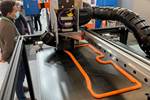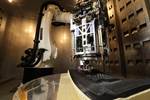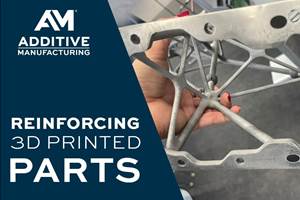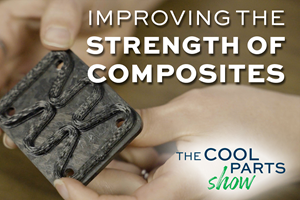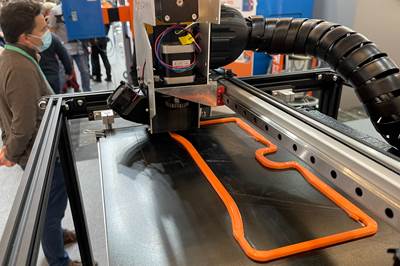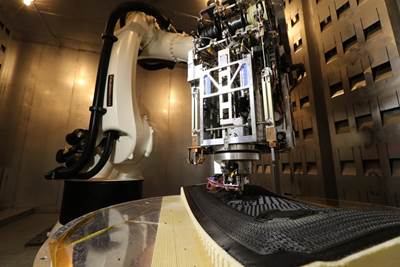Combining Multifunctional Thermoplastic Composites, Additive Manufacturing for Next-Gen Airframe Structures
The DOMMINIO project combines AFP with 3D printed gyroid cores, embedded SHM sensors and smart materials for induction-driven disassembly of parts at end of life.
The EU-funded DOMMINIO project (Digital method for improved Manufacturing of next-generation MultIfuNctIOnal airframe parts) began in January 2021 and will be completed in September 2024. Its goal is to demonstrate technologies that would enable multifunctional, intelligent airframe parts but that would also have benefits in repair and recycling at end of life (EOL).
Two demonstrator components by project partners — an aircraft spoiler from Aciturri and an access panel for a main landing gear door from BAE Systems — drove the use of thermoplastic composites (TPC) and a combination of automated fiber placement (AFP) for high-quality laminates with 3D over-printing for stiffening structures. Magnetic materials were also used to enable structural health monitoring (SHM) during service and intriguingly, disassembly at EOL for recycling and/or repair and reuse.
Another key focus within DOMMINO was to develop a data-driven methodology encompassing design, manufacturing and pre-certification of parts as well as maintenance/repair/overhaul (MRO) and EOL processes. This digital framework would include advanced simulation tools, online process and quality monitoring and SHM with a vision to achieve more cost-effective, efficient and sustainable high-quality components.
“The goal was to develop technologies that can accelerate more advanced and sustainable design, manufacturing and EOL strategies, and advance these to TRL [technology readiness level] 2 to 4,” explains Dr. Pablo Romero Rodríguez, team leader of Composite Additive Manufacturing at the research and technology organization AIMEN, which served as DOMMINIO project coordinator. “Thus, we are at the beginning of development, but I think we have shown significant results.”
TPC, functional materials
Thermoplastic composites (TPC) were the focus in DOMMINIO because they are not only structural, says Romero, but also functional materials that enable SHM and disassembly of structures. “Thermoplastics are reprocessable — they can be heated, melted, disassembled and reshaped. We are taking advantage of this to disassemble parts, and extend their life by repairing and reforming them.”
For AFP laminates, DOMMINIO used Toray Advanced Composites TC 1225 unidirectional (UD) tape comprising carbon fiber and LM PAEK polymer by Victrex. For 3D printing, three different types of polyetherketoneketone (PEKK) composite filaments were used:
- Structural: Commercially available PEKK filament with >40% continuous carbon fiber (cCF) reinforcement for local reinforcement by robotic laser-assisted additive manufacturing.
- SHM: PEKK filament reinforced with continuous carbon nanotube (cCNT) fiber for SHM, produced by AIMEN and co-developed with IMDEA Materials (Madrid, Spain) using Tortech Nano Fibers’ pilot plant in northern Israel.
- Disassembly: PEKK filament filled with magnetic nanoparticles (MNP) such as Fe3O4, CoFe2O4, and NiFe2O4 ranging from 2.5-10% by weight, co-developed with National Technical University of Athens.
“We are also developing another material that is piezoresistive for SHM,” says Romero. This work is in collaboration with IMDEA Materials Institute and was described in a 2022 CW news story:
“IMDEA Materials Institute notes that the technology being developed through the DOMMINIO project would not only enable real-time monitoring but would also implement advanced 3D printing techniques and advances in the production of carbon fiber nanotube (CNT) fibers to embed the sensor within the part during manufacture, rather than attach them post-production. This reduces the amount of electrical cabling required to power the sensors, which, in turn, could see aircraft become more fuel efficient and thus more environmentally friendly and cheaper to fly ...
Through these embedded sensors, the physical part is able to communicate directly with engineers on the ground. IMDEA Materials’ Multifunctional Nanocomposites group, led by Dr. Juan Jose Vilatela, is developing the CNT sensor and characterizing its piezoresistive properties when embedded in a composite part.
This embedding was achieved during part manufacture, which focused on combining AFP and fused filament fabrication (FFF), a 3D printing method using pre-made filament that can either be unreinforced or a composite, reinforced with short or continuous fibers.
Combining AFP and FFF
“DOMMINIO is about combining two additive manufacturing technologies: AFP for laminates and FFF for stiffeners,” explains Romero.
DOMMINIO demo part using AFP ISC to produce CF/LM PAEK laminate followed by FFF deposition of a gyroid core using unreinforced PEKK filament. Source | AIMEN, DOMMINIO project
This can be seen in a demonstrator stiffened panel at right. “We used laser-assisted AFP in-situ consolidation of TC 1225 tape as the bottom black skin, and FFF to produce the yellow-ish gyroid design on top with unreinforced Kepstan PEKK from Arkema. We also produced the top reinforcement layer with UD continuous carbon fiber-reinforced PEKK which provided better results with respect to porosity, using AIMEN’s proprietary FFF nozzle.”
Why PEKK? “It offers a better printability when we looked at the high-temperature advanced thermoplastic polymers used for structural composites,” explains Romero. “We needed a material that is amorphous, or that crystallizes slowly enough, so that the material is not suffering from too much warping. Thermoplastic materials typically contract as they cool down, and this will actually curve or pull the bottom skin when we produce the FFF stiffener on top of it. So, the more amorphous the material, the less shrinkage in the part and better dimensional stability.”
Typically, when producing TPC structures, achieving sufficient crystallinity (e.g., 35%) to produce high mechanical properties is crucial. However, for the FFF stiffeners, the PEKK gyroid is acting as a core providing thickness and stiffness — thus, crystallinity for strength is not crucial, but compatibility is. “PEKK has good compatibility with LM PAEK,” says Romero. “The adhesion is strong enough between the AFP laminate and the stiffener, that the thermal contraction from cooling as we print does not result in delamination between the parts. We expected some warping, so we had to optimize the manufacturing strategies. There is a lot of stress produced there, but the join between the PEKK and underlying LM PAEK laminate is strong enough to withstand those stresses.”
FFF process development
“We are manufacturing the stiffeners directly on top of the laminate,” he says. “In that first layer of the stiffener, we need super good consolidation. So, we use laser-assisted FFF that is like a mini-AFP system. It uses a laser to remelt the LM PAEK substrate as it deposits the PEKK filament, followed by a small compaction roller for consolidation. After the first layer, we continue building the gyroid and then we close it with UD continuous carbon fiber-reinforced PEKK using FFF on top.”
“The roller is very small, because we are compacting a filament of 2.85-millimeters-thick,” he continues. “Of course, as we deposit it onto the substrate, the width is a little bit larger, and this dimensional shift must be controlled. We found that, especially for continuous fiber filament, the compaction roller right after the nozzle increases the consolidation and strength of the laminate by 3X as compared to the process without laser”
Double extruder FFF system at AIMEN, combining pure PEKK and continuous fiber-reinforced PEKK filaments. Source | AIMEN, DOMMINIO project
For this FFF process, two nozzles were developed by Innovation Plasturgie Composites. “The first one works with 1.75-millimeter-diameter filament,” says Romero. “It is a small and versatile solution for non-planar printing of high temperature commercial filaments using PEKK or PEI [polyetherimide], for example. “This nozzle incorporates conformal air channels for cooling that allow us to tailor the temperature of the filament in the nozzle during printing,” he adds. “Numerous thermocouples and a pressure sensor can also be placed inside the nozzle for tight control of process parameters.”
The second nozzle was developed for a PEKK filament reinforced with continuous carbon fiber and uses similar cooling and process control measures. It can handle filaments less than 1-millimeter in diameter.
“The gyroid structure we used as a core for the stiffeners was something we had seen in proof-of-concept parts demonstrating the flexibility of AM to produce complex shapes,” says Romero. “The idea is that you can produce very tailored structures for stiffening components. So, we demonstrated that we can combine AFP and FFF to produce highly tailored different panels and then we completed three-point bending tests on these parts.”
Laser scanning for AFP
Laser scanner system developed by AIMEN for in-situ consolidation AFP. Source | AIMEN, DOMMINIO project
For the AFP process, DOMMINIO developed a scanning laser system. “Most of the laser heat sources used in AFP are static, producing a heated spot size that is static and constant,” explains Romero. “What we have developed is a scanning system that can adjust the laser area by moving an optic reflector at 50Hz, connected to a closed-loop control system monitored by a thermal camera.”
This system is similar to the CONTIjoin technology developed by Fraunhofer IWS for joining the upper and lower half shells of the Multifunctional Fuselage Demonstrator (see Temperature Control section of “Manufacturing the MFFD thermoplastic composite fuselage”.) In that system, the laser used to heat and apply CF/LM PAEK laminate to join the half shells was combined with a high-speed scanning system that oscillated the energy beam across the width of the weld.
“Our approach is similar,” says Romero, “because the external parts of the tape as we apply it are colder than the center. So, moving the laser helps achieve better consolidation across the whole tape. We have developed a closed loop control system, with a scanning element that works to measure and adjust the laser power and heat applied. This type of adaptive control enables adjusting the heating profile, not only across the tape width, but also as you increase the laminate thickness. When using heated tooling, for example, the more you place and increase the thickness, the further away the placed tape is from the heated tooling.”
He notes that AIMEN has tested this adaptive control system for laser-assisted AFP. “It works well and is another pillar from the DOMMINIO project, to make processes autonomous towards achieving zero-defect manufacturing setups.”
Non-contact inline inspection
“We are also developing, with DASEL SL a non-contact sensor for inline process monitoring and defect detection during AFP,” says Romero. “This is important because we are using in-situ consolidation (ISC), so there is no second step to get rid of defects during the AFP process. ISC is very efficient because you eliminate a second consolidation step in an oven or autoclave. But the manufacturing equipment still needs a lot of development to make consolidation more reliable across different kinds of tapes and parts.”
Non-contact inline inspection system developed during DOMMINIO for detecting defects in laminates during AFP ISC. Source | AIMEN, DOMMINIO project
“The non-contact inline technology we have developed measures defects right after the consolidation step using Lamb waves,” he explains. “The system uses hardware connected to the AFP head that sends and receives Lamb waves. There are two elements — a transducer and receiver. The transducer emits sound waves that enters the material and bounces back to the receiver. This sound wave signal measures information about consolidation such as material density. We then analyze that information to identify defects, such as voids.”
Romero notes this method is similar to phased array ultrasound (UT), but the latter requires a water or gel couplant. “The development is very challenging, because our AFP system was above 200°C due to the heated table we were placing onto. This temperature change causes turbulence problems as the Lamb waves travel through air that varied in density. But we were able to get good initial insight about the feasibility of such approach.”
Thermoplastic structural disassembly
After DOMMINIO produced manufacturing demo parts, it then worked to demonstrate how to disassemble them using functional materials. “We used magnetic nanoparticle-reinforced filaments that we deposited using FFF just at the interface between the AFP laminate and the gyroid core structure,” explains Romero. “Before the gyroid, we produced a layer using this material with embedded magnetic nanoparticles. And these nanoparticles react to magnetic fields, generated by a magnetic coil that our partners from NTUA have developed. As we moved this magnetic coil, we used induction to heat the interface so that the thermoplastic polymer melts and we could pull apart the skins from the stiffeners.”
Disassembled gyroid stiffener from CF/LM PAEK laminate using localized induction heating. Source | AIMEN, DOMMINIO project
“So, we can strategically heat up and remelt just the interface and we can disassemble the skin from the gyroid,” he continues. “The carbon fibers in the skin laminates do not react to the magnetic fields in the same way as the magnetic nanoparticles. We have developed a kind of tuning between the nanoparticles and the induction coil. We are basically bringing the concept of induction welding to remelt the interface, but for disassembly. We can call these reversible or circular structures based on these functional materials.”
Digital/cognitive developments
Developing a data-driven methodology for composite aircraft parts was also a key part of the DOMMINIO project. “The idea of the digital/cognitive system in DOMMINIO,” says Romero, “is that as you move through the product lifecycle — from product design through manufacturing to repair and EOL disassembly — you are generating data. We want to gather this data and try to find cross-correlations or relationships between parameters.”
“We wanted to design and simulate not just the part’s mechanical properties and structural performance, but also the manufacturing processes, including AFP and FFF,” he continues. DOMMINIO partners ESI Group and ENSAM simulated consolidation during these processes based on temperature and pressure. Romero’s team worked with them to simulate the thermal contraction of the printed gyroids as they cool.
“And then, when you start manufacturing, you gather data about the temperature, pressure and other process parameters, as well as the defects and quality factors,” says Romero. “The aim in DOMMINIO was to use this data to further predict part properties and compare this with the initial simulations to see if what you are obtaining is actually what you predicted. It is a validation and an indication of how far you are from what you are actually producing, and you can use that to improve your simulation tools. It also helps to understand what can be accepted in terms of aerospace products and defect levels. Those defects are identified and quantified, and that data can be included in the calculation of product allowables.”
After manufacturing, DOMMINIO’s methodology is to collect data during in-service via embedded SHM systems. “We embedded SHM sensors in the laminates with the idea that they would generate data all the time during service,” says Romero. “For example, this data can let you see if the product is not actually performing as expected, but also, it can alert that the part just suffered an impact or excessive load event as well as when repair or maintenance operations are performed.”
DOMMINIO project’s thermal monitoring of ATL and FFF processes and the digital twin representation enabled by the DOMMINIO digital thread. Source | AIMEN, DOMMINIO project
All this data is channeled across the digital thread. It encompasses all the data across the part lifecycle and can then be used to optimize the design and manufacturing of parts. It also supports multidisciplinary design optimization (MDO). “This is where you have a variety of factors during design such as cost, structural performance and aerodynamics,” explains Romero. “MDO allows you to consider all of these factors to find an optimum. For example, AM gives you a lot of design freedom to produce super complex parts which are very tailored, such as the gyroids for stiffeners. But there are also constraints. So, manufacturability is a key factor to include during design to integrate flexibility and constraints from the beginning of the lifecycle, particularly for AM processes.”
Impact on future composites
“I think the manufacturing concepts demonstrated in the DOMMINIO project have the possibility to widen the design space for composite structures,” says Romero, “by combining thermoplastic composites and multifunctional materials with innovative AM technologies into super-tailored designs. And these also have the ability to enable new EOL solutions, such as disassembly and reuse.”
He notes that AIMEN is now applying this approach in other EU-funded research projects, such as OVERLEAF, which is developing composite tanks for storing liquid hydrogen. “We are again combining FFF and AFP with thermoplastic composite materials, building demonstrators and looking at tank wall permeability and cryogenic performance,” says Romero.
Meanwhile, he believes DOMMINIO will have an impact on future composite aerostructures by bringing together three key developments:
- New advanced materials for multifunctional structures.
- Combining three AM processes to produce near-net shape thermoplastic products.
- Digitalization of the life-cycle for composite part design optimization and efficient EOL strategies.
“This holistic approach will enable new manufacturing solutions,” says Romero, “that will be key for achieving the next-generation composites being demanded by the aircraft industry.”
More From This Author
Ginger Gardiner reports on the composites industry for CompositesWorld with an engineering/materials background and more than 20 years of experience in the composites industry. SUBSCRIBE FOR MORE
Related Content
Robot Vs. Gantry for Large-Format Additive Manufacturing (Includes Video)
Additive Engineering Solutions, specialist at 3D printing very large parts and tools on gantry machines, now also uses a robot for large-format AM. Here is how the robot compares.
Read MoreLouisville Slugger Uses Formlabs Technology to Accelerate Innovation
Louisville Slugger relies on Formlabs’ Form 3 stereolithography 3D printer to create both prototypes and manufacturing aids for designs of the composite and aluminum bats swung by youth and collegiate players.
Read MoreVideo: Reinforcing (and Joining) Parts After 3D Printing
Reinforce 3D has developed a method that can be applied to strengthen 3D printed parts by feeding continuous fiber and resin through them. The technique also enables joining parts of various materials and manufacturing methods.
Read More3D Printed Preforms Improve Strength of Composite Brackets: The Cool Parts Show Bonus
On this episode, we look at a pin bracket for the overhead bin of an airplane made in two composite versions: one with continuous fiber 3D printed reinforcements plus chopped fiber material, and one molded from chopped fiber alone.
Read MoreRead Next
Faster FFF Build Rate Using Rectangular, Variable-Orifice Nozzle (Includes Video)
A new nozzle design plus sophisticated slicer software offer control over layer width in polymer 3D printing while the layer height stays constant.
Read MoreHow 3D Printing Will Change Composites Manufacturing
A Q&A with the editor-in-chief of CompositesWorld explores tooling, continuous fiber, hybrid processes, and the opportunities for smaller and more intricate composite parts.
Read MoreProfilometry-Based Indentation Plastometry (PIP) as an Alternative to Standard Tensile Testing
UK-based Plastometrex offers a benchtop testing device utilizing PIP to quickly and easily analyze the yield strength, tensile strength and uniform elongation of samples and even printed parts. The solution is particularly useful for additive manufacturing.
Read More

